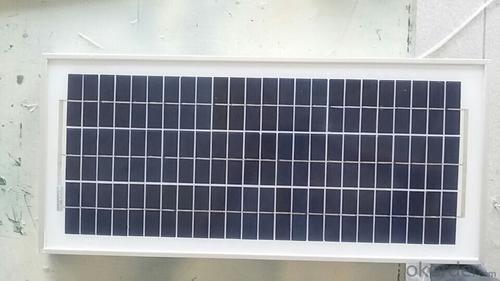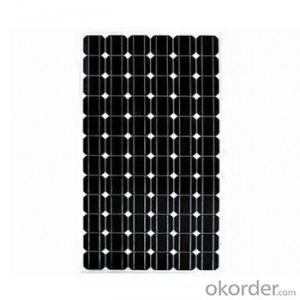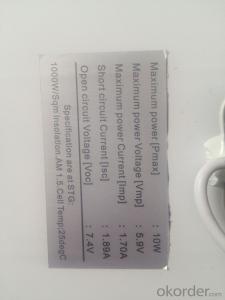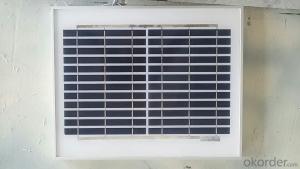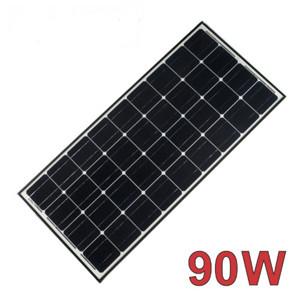Arlo Solar Panels - Monocrystalline Solar Panels 90W for Solar Systems
- Loading Port:
- Shanghai
- Payment Terms:
- TT OR LC
- Min Order Qty:
- 10000 watt
- Supply Capability:
- 50000000 watt/month
OKorder Service Pledge
OKorder Financial Service
You Might Also Like
Product Description
Solar Monocrystalline Series Panels
Introduction of Monocrystalline Solar Panels
CNBM Solar photovoltaic (PV) Panel is designed for large electrical power requirements. It is the optimal choice for both on-grid and off-grid power systems. CNBM Solar panel offers high performance of power per square foot of solar array. Monocrystalline silicon(c-Si): often made using the Czochralski process. Single-crystal wafer cells tend to be expensive, and because they are cut from cylindrical ingots, do not completely cover a square solar cell module without a substantial waste of refined silicon. Hence most c-Si panels have uncovered gaps at the four corners of the cells.
Characteristics of Monocrystalline Solar Panels
I Solar Cell : High efficiency crystalline solar cell. Even if under the weak light, the solar module can produce maximum power output.
II Tempered glass (toughened glass): Anti-reflecting coating and high transmission rate glass increase the power output and mechanical strength of solar module.
III EVA and TPT: Using high quality EVA and TPT to prevent destroying and water.
IV AI frame: Without screw, corner connection. 6 holes on the frame can be installed easily.
V Junction box: Multi function junction box with water proof.
VI Long lifetime: ≥25 years; Less power decrease
VII Good performance of preventing from atrocious weather such as wind and hails.
VIII Resisting moisture and etching effectively, not effected by geology.
Standard Test Conditions of Monocrystalline Solar Panels
The opto-electrical specifications shown below are stabilized values being measured at Standard Test Conditions, Irradiance: 1000W/m2, Spectrum: AM1.5 at 25°C, The info below is subject to manufacturing tolerances. Where appropriate minutes of measurement are available and are used for the dimensioning of the installation.
Advantages of Monocrystalline Solar Panels
1.High reliability with guaranteed -3% to +5% power output tolerance, ensuring return on investment
2. High conversion efficiency based on leading innovative photovoltaic technologies
3. Withstands high wind-pressure and snow load, and extreme temperature variations
4. Attractive appearance Unique frame design, high mechanical strength, and easy Installation
Characteristics of Monocrystalline Solar Panels
Max Power Voltage Vmp (V) | 17.4V | 17.8 V |
Max Power Current Imp (A) | 5.33A | 5.79A |
Open Circuit Voltage Voc (V) | 22.2V | 22.4V |
Short Circuit Current Isc (A) | 5.17A | 5.62A |
Max Power Pm (W) | 90W | 100W |
Temperature Coefficient of Cells
NOCT | 47℃±2℃ |
Temperature Coefficients of Isc (%/℃) | 0.06 |
Temperature Coefficients of Voc (%/℃) | -0.33 |
Temperature Coefficients of Pmp (%/℃) | -0.45 |
Mechanical Data Solar Monocrystalline Series
Power | 90W/100W |
Dimension | 1190×550×30mm |
Weight | 8 kg |
Tolerance | ±3% |
The dimension of the modules can be changed according to the demand of clients Limits.
Operating Temperature | –45 °C to +80°C |
Storage Temperature | –45 °C to +80°C |
Max System Voltage | 700V |
Guarantee Solar Monocrystalline Series Panels
Products Guarantee | 10 years free from defects in materials and workmanship |
Performance Guarantee | No less than 90% within 10yrs and no less than 80% within 25yrs |
Certificates | IEC, ISO, TUV, CE |
Dimension of Solar Monocrystalline Series Panels
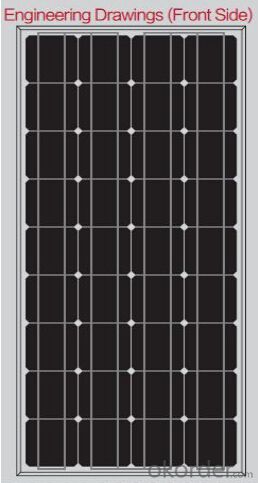
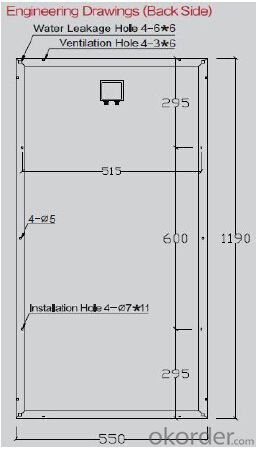
FAQ
We have organized several common questions for our clients,may help you sincerely:
1. What’s price per watt?
A: It’s depends on the quantity, delivery date and payment terms of the order. We can talk further about the detail price issue. Our products is high quality with lower price level.
2. Can you tell me the parameter of your solar panels?
We have different series of cells with different power output, both from c-si to a-si. Please take our specification sheet for your reference.
3. How do you pack your products?
We have rich experience on how to pack the panels to make sure the safety on shipment when it arrives at the destination.
4. What is your warranty system?
Our product performance guarantees for 25 years
• 12 years guarantee for workmanship
• Timeliness of delivery
• Quality Products certified (TÜV, UL, CE, ISO)
5. How do you pack your products?
We have rich experience on how to pack the panels to make sure the safety on shipment when it arrives at the destination.
- Q: How can solar panels be integrated into building designs?
- Solar panels can be integrated into building designs by incorporating them into the structure or facade of the building. This can be done by installing solar panels on the roof, as awnings, or as part of the building's walls or windows. Additionally, innovative designs like solar shingles or solar glass can also seamlessly integrate solar panels into the overall aesthetics of the building.
- Q: How much electricity does a solar panel produce?
- The amount of electricity a solar panel produces depends on several factors, including the size of the panel, its efficiency, the amount of sunlight it receives, and its location. On average, a standard residential solar panel can produce anywhere from 250 to 400 watts of electricity per hour under optimal conditions.
- Q: I have a home in Manchester Tn and we have been slowly remodeling the home. It is about 200 sq ft of living space. Our normal electric bill is about 50 a month. We would like to add some solar panels to the home to help reduce the amount of the bill. How many panels do I need and what would be the cost? I am not trying to go completely of the grid but I would like to start somewhere and maybe over the years be able to add. What is your recommendation for a reasonable cost of under 2 to 3 k??
- Ok, well there are also other alternative energy sources, too, besides solar. There is tidal (but you need an ocean :] ), hydroelectric (river, stream, etc.), biomass/biofuels (burning garabage), geothermal (from within the earth, pipes in the earth), wind (windmills, wind, the sun to get wind), and there are others that don't come to mind. Solar energy would cost alot to be installed, and it would take up alot of space, but once installed it pays for itself and uses little to no labor. They all have positives and negatives. All of these are clean and renewable. Here are some sites that my teacher/professor gave us (we just ended alternative energy lesson.) Well I hoped this helped!
- Q: cheapest price for a 20 watt solar panel sold on line
- If okorder /... , cost $75 each. I haven't personally tried that product, but the company has been around for a long time, and is not a fly-by-night. If it has to last, there are dozens of places online that will sell conventional sealed panels. Expect to pay $2.00 a watt on up nowadays.
- Q: Can solar panels power an entire house?
- Yes, solar panels can power an entire house. By installing a sufficient number of solar panels and utilizing a battery storage system, it is possible to generate and store enough solar energy to power all the electrical needs of a house. However, the size of the solar panel system required depends on various factors such as the energy consumption of the house, geographic location, and available sunlight.
- Q: Can solar panels be installed on a winery or vineyard?
- Yes, solar panels can be installed on a winery or vineyard. In fact, many wineries and vineyards have embraced solar energy as a sustainable and cost-effective solution to power their operations. The large open spaces, such as rooftops or unused land, provide ample opportunities for installing solar panels, which can help wineries and vineyards reduce their carbon footprint and lower energy costs.
- Q: Can solar panels be installed on oil or gas facilities?
- Yes, solar panels can be installed on oil or gas facilities. This is known as hybrid energy systems, where solar panels are integrated with traditional fossil fuel facilities to generate electricity. This combination allows for the diversification of energy sources, reducing reliance on traditional fuels and minimizing carbon emissions. Additionally, solar panels can help offset the energy consumption of oil or gas facilities, making them more sustainable and environmentally friendly.
- Q: And how do you choose the best one for the best price?I saw a 400 watt monocrystalline solar panel
- The polycrystalline solar panel has a longer life-span and has a higher efficiency. What this means is that from the energy that 'hits' the solar panel, more is caught and used to convert into electrical energy. A polycrystalline solar panel will have an efficiency of about 4%. The monocrystalline solar panel has a similar efficiency but the cells are prone to sunlight, so the efficiency drops over the years.
- Q: So I'm trying to figure out what to ask for my birthday because its one of the few times I can get stuff for no reason, like stuff I don't normally go to the store to buy. (i dont go to the store to get much at all anyway).Anyway, I'm interested in solar panels and led and electronics and i was wondering if there is anything not over expensive that would be cool. Some things I'm interested in:solar, wind, water energyGadgets (multitools, swiss army knives)Vibram fivefingersdrawingmaking stuff (duct tape wallets, stuff out of altoids containers)basically technology and outdoors-gear stuffoh and im 6 turnin 7 male.
- solar panel is expensive, but small solar panel is not expensive, for example, 5w solar panel, solar light also not expensive led light also not expensive. i am not sure about other stuff that you said
- Q: So idk how to connect a solar panel to a battery ...is it like a series connection from the solar panel to the battery, or a parallel connection from solar cell to battery? (to charge) please and thank you
- I agree, you should get a charge controller and install appropriate fuses.
Send your message to us
Arlo Solar Panels - Monocrystalline Solar Panels 90W for Solar Systems
- Loading Port:
- Shanghai
- Payment Terms:
- TT OR LC
- Min Order Qty:
- 10000 watt
- Supply Capability:
- 50000000 watt/month
OKorder Service Pledge
OKorder Financial Service
Similar products
Hot products
Hot Searches
Related keywords



